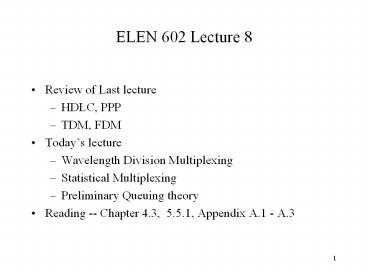ELEN 602 Lecture 8 - PowerPoint PPT Presentation
1 / 18
Title:
ELEN 602 Lecture 8
Description:
ELEN 602 Lecture 8 Review of Last lecture HDLC, PPP TDM, FDM Today s lecture Wavelength Division Multiplexing Statistical Multiplexing Preliminary Queuing theory – PowerPoint PPT presentation
Number of Views:113
Avg rating:3.0/5.0
Title: ELEN 602 Lecture 8
1
ELEN 602 Lecture 8
- Review of Last lecture
- HDLC, PPP
- TDM, FDM
- Todays lecture
- Wavelength Division Multiplexing
- Statistical Multiplexing
- Preliminary Queuing theory
- Reading -- Chapter 4.3, 5.5.1, Appendix A.1 - A.3
2
Statistical Multiplexing
Input lines
A
Output line
B
Buffer
C
3
Dedicated versus Shared Lines
(a)
A1
Dedicated Lines
A2
B1
B2
C2
C1
(b)
Shared Line
B2
C2
A2
B1
C1
A1
4
Number of Packets in System
(a)
A1
A2
Dedicated Lines
B1
B2
C2
C1
(b)
Shared Line
A2
B1
B2
C2
C1
A1
(c)
N(t)
5
TDM/FDM/WDM Multiplexing
- In TDM, FDM, and WDM link capacity is subdivided
into m portions - A packet of length L takes L/(C/m) Lm/C time
- Resources are allocated to individual streams
- some streams may have empty queues while others
may have long queues - Delay behavior dependent on individual stream
arrival - Resources could be wasted
- Statistical multiplexing -- no resource wastage
- smaller delays, but larger delay variance
- In TDM/FDM/WDM -- no need for packet headers
- less overhead, simpler packet processing
6
Network Delay Analysis
Delay Box Multiplexer Switch Network
Message, Packet, Cell Arrivals
Message, Packet, Cell Departures
T seconds
Lost or Blocked
7
Arrival Rates and Interarrival Times
n1
A(t)
n
n-1
2
1
t
?2
?n
?1
?n1
0
?3
Time of nth arrival ?1 ?2 . . . ?n
n arrivals
1
Arrival Rate
1
E?
?1 ?2 . . . ?n seconds
(?1?2 ...?n)/n
Arrival Rate 1 / mean interarrival time
8
Littles Theorem
T
A(t)
D(t)
Delay Box
N(t)
9
Littles Theorem
- N ? T
- N Average Number of packets in the system
- ? Packet Arrival rate
- T Average Service Delay per packet
- Larger the service delay (queuing delay service
time), larger the number of waiting (or buffered)
packets - Higher the arrival rate, larger the number of
buffered packets
10
Arrivals and Departures in a FIFO System
A(t)
T7
Assumes first-in first-out
T6
T5
T4
D(t)
T3
T2
T1
Arrivals
C1
C2
C3
C4
C5
C6
C7
C1
C2
C3
C4
C5
C6
C7
Departures
11
Exponentail interarrival
Probability density
?e-?t
0
t
12
Queuing Model Classification
Arrival Process / Service Time / Servers / Max
Occupancy
Interarrival times ? M exponential D
deterministic G general Arrival
Rate ???????E?
Service times X M exponential D
deterministic G general Service
Rate ???????EX
K customers unspecified if unlimited
1 server c servers infinite
Multiplexer Models M/M/1/K, M/M/1, M/G/1,
M/D/1 Trunking Models M/M/c/c, M/G/c/c User
Activity M/M/?, M/G/ ?
13
Queuing System Variables
N(t) number in system
N(t) Nq(t) Ns(t)
Nq(t) number in queue
Ns(t)
Nq(t)
Ns(t) number in service
1
?????Pb)
2
?
?
T total delay
c
W
X
W waiting time
??Pb
T W X
X service time
14
M/M/1K Queue
15
A Markov State transition diagram
1 - (???????t
1 - (???????t
1 - (???????t
1 - (???????t
1 - (???????t
1 - ???t
???t
???t
???t
???t
n
2
n-1
0
1
n1
???t
???t
???t
???t
16
Average Packet Delay vs. Load M/M/1/10
Finite buffer multiplexer
Normalized average delay
Load
17
Packet loss probability vs. Load M/M/1/10
Loss probability
Load
18
Average Delay with infinite Buffers
M/M/1
Normalized average delay
M/D/1
Load































